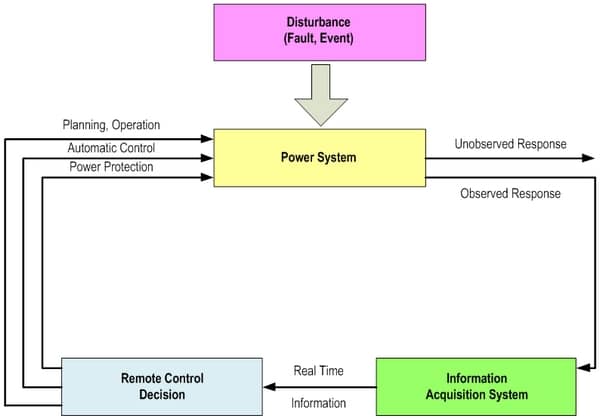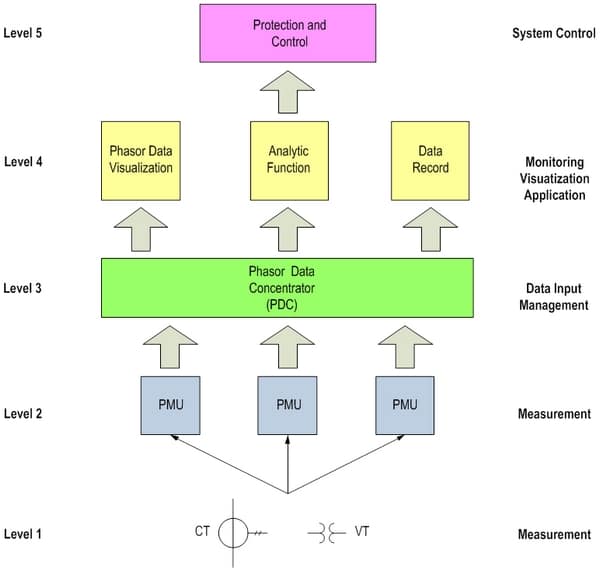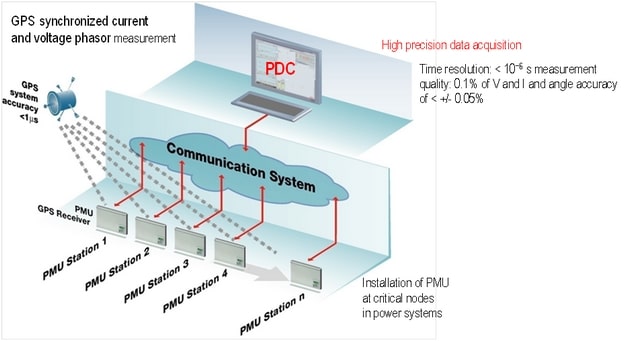
We thought that it would raise your interest so enjoy your reading!
Introduction
The growth of electrical power systems is a challenge for Energy Management Systems to ensure a safe and reliable operation.
This situation originates the need for tools that help to visualize and control electrical system variables using high speed communications channels and accurate data, allowing the grid operator to estimate the state of the system in real time through mathematical calculations.
New technologies for monitoring electrical systems implement Phasor Measurement Units, as a main element of measurement, to generate synchronized actions with sampling times exceeding those currently obtained with conventional SCADA systems.
This articles shows the process of conceptualization, components and architecture required for the implementation of a WAMS data acquisition system for Electric Power System.
Why Wide Area Monitoring Systems?
Power management, as a tool for the security analysis to ensure reliability and economical operation of the electrical system, are heavily dependent on the accuracy of the data provided by the measuring equipment installed on the system.
In recent years, progress in system monitoring (power and control) has been possible because of Wide Area Monitoring Systems (WAMS) that implement Phasor Measurement Units (PMUs).
When a PMU is installed on a node, it is possible to measure voltage and current phasors in some or all adjacent areas to this node with high accuracy, enhancing the efficiency of methods for fault detection and allowing to make decision to keep system stability.
Real Time information
Real time data is a source of valuable information for automatic control as well as for maintaining the stability of electrical power systems. It can also be used as a starting point for defining actions to recover the system after a failure.
The analysis and evaluation of different events previous to a blackout have shown that a wide view of the network, as well as the availability of real time information is a critical factor for the stability and reliability in the power supply.
With high speed real-time measurements, appropriate protection and control actions might be taken to ensure the reliability of the power system during the occurrence any event.
Figure 1 shows the relationship between the real time information and the decision-making process:

Figure 1. Relationship between the real time information and the decision-making process
Real time information acquisition and transmission are key for the optimization of the system operation in Wide Area Monitoring Systems. In this regard, the communication architecture should be able to offer dynamic information in real time and operational data for those who need it and when they need it.
The communication infrastructure should have the following characteristics:
- Bandwidth with capability to support the supervision of large area power systems with high speed data transmission.
- Low latency to support local area and wide area for protection and real-time control.
Wide Area Monitoring Systems
Wide Area Monitoring Systems (WAMS) are essentially based on data acquisition technology of phasor measurements, in order to monitor the transmission system conditions over large areas, in view of detecting and further counteracting grid instabilities.
Current, voltage and frequency measurements are carried out by PMUs at selected locations in the power grid (Generation, Transmission and Distribution systems) and stored in a data concentrator every 100 milliseconds (figure 2).
The measured variables include both magnitudes and phase angles, and are time-synchronised via Global Positioning System (GPS) receivers with an accuracy of one microsecond.
The measured phasors provide instantaneous snapshots of the status of the monitored nodes. By comparing the snapshots with each other, not only the steady state, but also the dynamic state of critical nodes in Generation, Transmission and Distribution Systems can be obtained. Thereby, a dynamic monitoring of critical nodes in power systems is achieved.
These early warnings in the system contributes to increase system reliability by avoiding the spreading of large area disturbances, and optimizing the use of assets.

Figure 2. Substation Automation System and PMUs
The implementation of a WAMS contributes to get an electrical system with the following characteristics:
- Security
- Power system stability
- Observability of networks
- Network controllability
- Blackout prevention
Wide Area Monitoring Systems Components
Wide Area Monitoring Systems collect the information from the power system, analyze the data and interpret the result, giving “warnings” to the system operator or initiating “defense schemes” in order to prevent stability problems.
WAMS consist of the 3 major components: Phasor Measurement Unit (PMU), Phasor Data Concentrator (PDC) and communication channel.

Figure 3. Wide Area Monitoring Systems Components
Wide Area Monitoring Systems architecture
Phasor Measurement Units are the input equipment for WAMS. PMUs measure voltage, current, frequency and frequency change rate as C37.118 standard and send to PDC based on the synchronizing time set on GPS. Then, the Phasor Data Concentrator processes, monitores and analyses the input data. Finnally, the communication channel is responsible to transfer data from PMUs to PDC.
The implementation of this architecture may have several objectives, however, I can be stated that WAMS basically allow to:
- Validate simulation models: comparison of simulation data with measured values of the PMUs.
- Identify system response with an analysis of the corresponding system damping.
- Improve state estimation in the Energy Management System (EMS).
- Estimate the system stability index.
- Use as the guidelines for blackout restoration.

Figure 4. Wide Area Monitoring Systems Architecture
Conclusion
The Wide Area Monitoring Systems collect, store, transmit and analyze critical data from key access points in power system, spread over large geographical areas, helping power system operators to continuously analyze all variables in real time to ensure a reliable power supply to customers.
Fellow electrical engineers senior or students, don’t hestitate to leave your comments below.